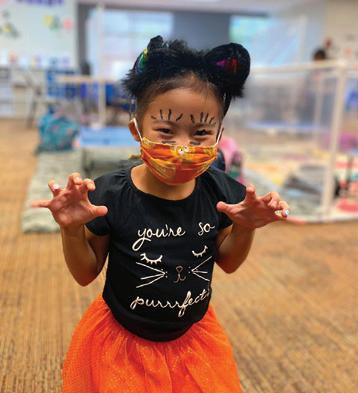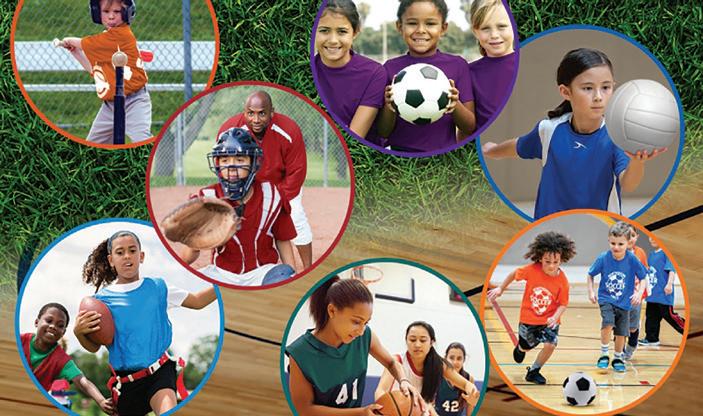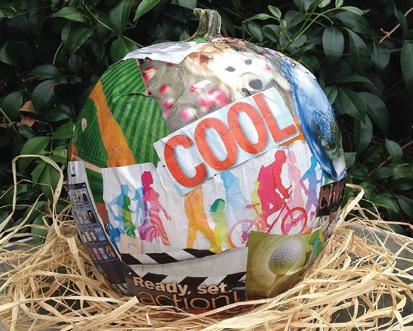
21 minute read
NAVIGATING THE WATERS OF CHILDHOOD
NavigatiNg the Waters Of ChildhOOd NavigatiNg the Waters Of ChildhOOd
Adolescence is tricky enough for kids, even under the best of circumstances; when issues like teasing and bullying are thrown into the mix, learning to cope can feel downright overwhelming. Instilling confidence and compassion is key in raising happy, successful kids. Sometimes, this requires a team approach. There are a wide range of issues that can negatively affect a child’s academic performance and social development—all of which, in turn, can impact self-esteem.
Advertisement
Strategies For Handling Bullying
One of the biggest concerns involves bullying. Children are teased for any number of reasons, ranging from clothing choices and hairstyles to physical appearance. Often, the tormentor is struggling with insecurities of their own, has power or control issues, or is experiencing discord at home. Bullying doesn’t necessarily involve ongoing abuse; often, a single act can cause a child to withdraw, leading to long-lasting repercussions. The best solution is to educate kids about bullying. The term itself is open to interpretation, ranging in severity from a single instance of being teased to frequent emotional and/or physical abuse. Once kids understand the definition of bullying, they are taught strategies for coping with it. One of the most effective is to ignore the taunting and walk away when it occurs. The more kids engage, sometimes that’s what the bully is looking for. Empowering kids who are being bullied is a really important piece. Teaching them to use their “big kid voice” is another form of empowerment. Sticking up for themselves, or others who are being bullied, may be enough to dissuade the bully from acting out. Ignoring somebody who is picking on you is often helpful. If bullying continues, kids shouldn’t be afraid to tell an adult. Teachers are good at monitoring situations and can keep an eye on students during recess and lunchtime interactions. It’s acknowledged the difficulty in convincing children to let a grownup intervene once they reach a certain age because they are afraid of stepping on other people’s toes or being labeled a tattletale. Kids handle it a lot differently than we tell them to because they’re dealing with their peers.
Parents have an important role to play in bullying prevention, as well. Parents should familiarize themselves with the school’s policies and procedures and be willing to reach out to the school when there is a problem. As role models, they should teach their kids basic skills such as communication, sharing, problem-solving, and dealing with other people. Learning how to handle situations will empower children to advocate for themselves and is a key component in both social-emotional development and conflict resolution. So many kids are being put in schools and expected to get along. Kids aren’t natural learners on how to share and take turns; nobody has taught them how to get along and solve problems. We need to teach that as parents and professionals. You might be surprised to learn that both self-confidence and empathy can be taught, as well. Putting in the effort can pay big dividends: children with positive selfesteem are confident in their abilities, feel liked and accepted, are proud of their achievements, and value their individuality. They believe in themselves, learn from their mistakes, are more likely to stand up for themselves, and are unafraid to ask for help when needed. They are also more resistant to peer pressure. Instilling self-confidence isn’t difficult. Praise your kids, focusing on their efforts rather than the results, but don’t overdo it or you’ll condition them to expect it every time. Encourage them to think independently by solving their own problems (but always offer a helping hand if needed). Be a good role model by teaching them that failure is an important part of the learning process, and seek out new experiences together. Empathy is the ability to understand what other people are feeling and sense their emotions. By putting yourself in somebody else’s shoes, you’re better able to sympathize with them. There is some debate over whether empathy is a learned behavior or a fixed trait. You’re born with certain traits and genetics, and your environment can either capitalize on that or hinder your potential. The most basic way to teach your child empathy is to practice it yourself. Bond with your child in order to cultivate a trusting, secure attachment. Kids who are brought up in
Children who are loving, stable environments empathetic are are better suited to dealing with emotions and coping much less likely to with stress than kids who lack that parental support. bully others, and As with self-confidence, will often step in and model empathetic behavior yourself by treating support friends who others with kindness are being victimized. and understanding. Acknowledge their feelings and respond with sympathy. Offer positive encouragement when your kids display empathy toward others. We can teach kids how to share, take turns, and communicate, actions that help teach empathy. Another key is to acknowledge and identify emotions. If your child is upset, for instance, don’t dismiss their negative feelings; instead, respond with a statement like, “Oh no, you’re angry.” This helps kids learn to identify emotions in themselves and others and encourages sympathy and understanding. Parenting is often a challenge, but remember, you and your child have access to a support network of skilled individuals trained to help. Teachers, counselors, school psychologists, can all play an important role in your kids’ well-being.

It's all natural...PERIOD
The misconceptions and facts of menstruation
Menstruation, or having a “period,” is natural! Everyone goes through a stage called puberty as they grow up - In females, part of this involves getting your first period. It is exciting, but can also be confusing. What is normal and what should I expect? Our experts have the answers to many commonly asked questions.
Heidi Purcell, MD Obstetrics/Gynecology THE CLINIC AT WAIMEA • (808) 338-8311
What is a normal period? There is no such thing as a textbook normal period - Variation exists between individuals. Instead, we talk about normal ranges. The average age of menarche (the first period) is about 12 ½ but in some cases start as early as 10 and as late as 16 years old. Normal bleeding is using anywhere from 3-6 pads or tampons per day during your period. Normal periods range from every 21 to 45 days, and should last 2-7 days. In the first two years after menstruation starts, it is common to have more variation between cycles, but they should start to become more regular after 3 years. At what age should I speak to a gynecologist if I haven’t started my period? Some of us are late bloomers, and that is okay. Women typically start menstruating 2 years after breast developments begins but in general, we recommend seeing a gynecologist if you haven’t started having your period by age 15 regardless of breast development.
How much is “too much” bleeding? The upper limit of normal blood loss during a period is 80 milliliters, or less than 3 oz. Unfortunately measuring blood loss during your period is incredibly difficult. A more useful rule of thumb is that soaking through a pad or tampon every 1-2 hours is a sign of too much bleeding and can indicate underlying problems.

LEARN - REQUEST - SUPPORT www.maimovement.org

What causes irregular periods? So many things! Hormone imbalances and underlying disorders like polycystic ovarian syndrome are the main cause for irregular menstrual cycles in young women. Other health concerns like thyroid disease, infections, extreme stress, or inadequate nutrition can cause irregular cycles as well. Best to check-in with your doctor if your cycles are irregular.
When should I talk to my child about menstruation? We recommend starting the conversation in the pediatrician’s office and at home around 7-8 years old. Providing anticipatory guidance can help prepare your children to know what to expect and that it is a normal process. Talking about how to use menstrual hygiene products is helpful, as is discussing what is considered normal flow.
What causes cramps? During your period, the uterus becomes inflamed and the muscular walls contract to help shed the lining and cause bleeding. This can be quite uncomfortable, but fortunately often responds well to over the counter medications like Ibuprofen. Other conditions such as endometriosis or fibroids can also cause pain, so if the over the counter meds aren’t working, it may be time to see the doctor.
How do I clean the vagina? Is it different after menstruation? The vagina is self-cleansing. There is no need to use any special soap or solutions (referred to as “douching”) inside the vagina as this can disrupt the balance of healthy bacteria and actually cause infection and irritation. Outside the vagina, on the labia, we recommend just water and if necessary a gentle pH neutral and unscented soap. During your period, change your pad every four hours or tampon every eight hours while awake to keep unhealthy bacteria away.
Cont' on next page
Hawaii Health Systems Corporation - Kaua'i Region THE CLINIC AT WAIMEA • (808) 338-8311
END PERIOD POVERTY IN HAWAI'I MA'I MOVEMENT


The misconceptions and facts of menstruation
Cont': The misconceptions and facts of menstruation True/False Questions
True or false: Birth control is only used to prevent pregnancy FALSE! We also use contraception to regulate flow, duration and timing of cycles. It is also useful in treating acne, mood swings and pain associated with your period. True or false: Using contraception as a teenager or for a prolonged time will cause infertility FALSE! Sometimes birth control will mask underlying problems though, which is why it sometimes gets a bad reputation. True or False: You can’t get pregnant during your period FALSE! Although it is unlikely, it IS possible, especially if your cycle length is short or irregular. Sperm can live up to 5 days inside a woman’s body. In addition, not all vaginal bleeding is from a period. Don’t get tricked into believing this myth and take precautions to prevent pregnancy if it is not desired. True or False: You can swim during your period TRUE! It may be logistically difficult on heavy flow days, but on regular or lighter flow days using tampons or menstrual cups makes it possible to enjoy the water without a mess and without risking your health.
When should my daughter start going to the gynecologist? What should she expect?
It’s great to emphasize that going to the gynecologist is one way to honor your body - both by taking care of it and being healthy. Once she becomes sexually active, or by age 21 (whichever comes first) she should establish care with a gynecologist. If either you or she has concerns about her period, we are always happy to meet for an appointment. Usually a pelvic exam is not needed to start contraception and for many concerns or first-time visits, we don’t need to do any internal examination. Depending on the problem, we sometimes order pelvic ultrasounds or blood work. The first visit is a great time to discuss topics like STD screening, safe sex and birth control.
Meet our OB/GYN Team at THE CLINIC AT WAIMEA Call for an appointment at (808) 338-8311
(Photo L/R) Graham Chelius, MD - Obstetrics/Family Medicine Heidi Purcell, MD - Obstetrics/Gynecology Amy Guyton, MD - Family Medicine w/Obstetrics Surachat Chatkupt, MD - Obstetrics/Gynecology

4 Ways to Approach Boundaries and Expectations with Youth
by Lindsay Fernandez Richardson, MS, LMHC
Studies show that setting boundaries and expectations, or clear limits and rules, is important to help young people thrive. Youth tend to grow into healthier, happier adults when adults use authoritative parenting, a style of parenting that combines boundary setting with compassion and warmth. Here are some ways adults can try setting limits with young people.
1. Talk about rules and consequences both beforehand and when issues come up.
• Share the reasoning behind your expectations and take an interest in your child or teen’s feelings.
Hearing them out doesn’t have to mean changing limits, and listening to youth can help them accept boundaries.
• Try a kind and honest approach over harsh criticism or shaming. Think of limits and consequences as tools for teaching and keeping youth safe.
2. Strive for a balance between supporting youths’ emerging independence and monitoring their whereabouts.
• Stay in contact to be aware of their location, what they’re doing, and who is with them. • Set guidelines for where youth can or cannot go, how they communicate, and what time they should return.
Respond with fair consequences if they break the rules.
3. Be a positive role model and support youth in connecting with positive influences.
• Demonstrate thoughtful decision making and talk with youth about ways you and others benefit from healthy choices.
4. Encourage youth to try their best to make choices that reflect their family’s values.
• Try saying, “Remember how we talked about looking out for others? Looks like your uncle has a lot of boxes to bring inside. What do you think about offering some help,” or, “I see that you’ve taken more responsibility for your school work lately, and I’m proud of you.” Source: 40 Developmental Assets® www.searchinstitute.org
Scan this QR code for more information and resources:

Kandi Bloss, RN, BSN, Maternity Education Coordinator Hawaii Health Systems Corporation – Kauai Region
Have you ever wondered why it is important for new moms to receive prenatal education? Knowing and understanding how eating healthy, getting enough rest and exercise, reducing stress and seeing your obstetrician regularly throughout your pregnancy are important to you and your baby’s overall development.
Why is Group prenatal and childbirth education beneficial?
Moms can get information about upcoming prenatal and childbirth education classes at their initial visit with their obstetrician. These classes have valuable information on prenatal development, what to expect during each trimester of your pregnancy and the laboring process. Classes focus toward a group setting that encourages building relationships with other parents who are having similar experiences with their pregnancy as you. It is also a safe-zone to ask as many or as little questions as you see fit.
Daily exercise and eating healthy.
Moms are encouraged to put their health first—making healthier food choices like more fruits and vegetables and less sugary foods into their diet. Low impact exercises, yoga or a daily walk also helps to minimize unnecessary weight gain and helps your body prepare for the labor and birth of your baby. Beginning this fall, the HHSC—Kauai Region KVMH will be participating in the Pregnancy Program from the Centering Healthcare Institute. It focuses on bringing 8 to 10 women all due at the same time together for their care. This allows moms and providers to relax and get to know each other on a much deeper and meaningful level. Members of this group form lasting friendships beyond traditional care.
For more information on Prenatal Education and Patient Centering call Kandi Bloss, RN at (808) 651-7898. If you’d like to connect with any one of our obstetricians (Drs. Chatkupt, Chelius, Purcell or Guyton), call the Clinic at Waimea at 808-338-8311, today.
Healing Horses Kauai Youth Horsemanship Camp

Fall Camp: October 3 thru October 7th Volunteer Orientation & Training: October 8th & 9th Halloween Photos: October 31st, 2:30pm-4:30pm Register online at: www.HealingHorsesKauai.org Email: hhkauai@gmail.com Phone: 808-634-3896
Support provided by Hawai‘i Tourism Authority through the Community Enrichment Program.
Online SPANISH LESSONS For Kids

Classes begin the week of September 12
Maestra Ana has been teaching Spanish to children on Kaua’i for over 15 years. www.FunWithSpanishForYou.com 808-482-1863

Kaua ʻi ‘Ōpio and Keiki Orchestra
REGISTER ONLINE NOW! FREE!
Fall Registration Begins Monday, August 1, 2022 Please visit www.kauaikeikiorch.org to register now!
Boys and Girls Clubhouse, Kapa’a AND Boys and Girls Clubhouse Lihue offer fall classes for ages 7 to 18 years old.
KOKO offers PreK classes on Saturdays at ‘Ohana Christian Fellowship, Kapa’a.
Join us for Fall Break
West Kauai Club 320-8353
Kapaa Clubhouse 821-4406
October 3-7
FALL Art Contest

Send email to
by October 13th

One of you will win the book Honu and Hina by Patrick Ching and Friends
1
Here is how you can draw the 109 year old Kilauea Lighthouse using a simple three step process: Step 1. Forming:


Form up the lighthouse pressing softly with your pencil making the base like a rectangle that is slightly larger at the bottom than the top. Then put a square where the light casing is, and a triangle for the cap. Put a ball on top of the triangle with a point on it and the oval inside the square for the light. Then make a rectangle doorway with a triangle top and ad the windows and railings.
2
Step 2. Outlining:
Now make anything you want around the lighthouse like birds, clouds, ocean, whales, get creative! When you have things the way you want them, press harder or use a pen to outline your drawing.
Step 3. Shading & Coloring:
Figure out what direction the sun is shining on the lighthouse and shade it on the other side. Advanced artists can use reflective light on the shaded side.
3

Summer Art Contest Winner: Lily Millard, Age 7, 2nd grade Wilcox Elementary
It’s easy to submit your art for our contest. Email us, and include your name, age, grade, school and phone number. eMail your art to: info@kauaifamilymagazine.com
Is Thumbsucking Bad for My Child’s Teeth?
By Michael Lutwin, DDS, Kalaheo Dental Group
Thumbsucking is a natural reflex for children. Sucking on thumbs may make babies feel secure and happy and help them learn about their world.
Once permanent teeth come in, sucking may cause problems with the proper growth of the mouth and alignment of the teeth. The intensity of the sucking is a factor that determines whether or not dental problems may result. If children rest their thumbs passively in their mouths, they are less likely to have difficulty than those who vigorously suck their thumbs. Children usually stop sucking between the ages of two and four years old, or by the time the permanent front teeth are ready to come in.
How Can I Help My Child to Stop Thumbsucking?
• Praise your child for not sucking. • Children often suck their thumbs when feeling insecure or needing comfort. Focus on correcting the cause of the anxiety and provide comfort to your child. • For an older child, involve him or her in choosing the method of stopping.
If these tips don’t work, remind your child of their habit by bandaging the thumb or putting a sock on the hand at night. Your dentist or pediatrician may offer more specific guidance and can even prescribe a bitter medication to coat the thumb or the use of a mouth appliance.
We’re here for you!
Making ends meet is tough. Dr. Lutwin, Dr. Rita, Dr. Stebbins, and our friendly staff are here to make your ohana’s dental care manageable and comfortable.

Rainbow Plaza 2-2514 Kaumualii Hwy., Suite 204 Kalaheo, HI 96741 kalaheodental.com • (808) 332-9445
Make an appointment today at (808) 332-9445
Payment Options:
• Most major insurances accepted • Interest-free CareCredit monthly financing • In-office payment plans • No insurance? Our membership plan offers preventative services and 20% off other treatments.
Services:
• Family Dentistry • Dental Implants • Teeth Whitening • Invisalign • Porcelain Veneers • Tooth Replacement

We love our community! We support local nonprofits, provide school presentations, and host the annual Halloween Candy Buy Back and Keiki Art Contest.
In the US, about 35% of children and teens are overweight or obese, according to the Centers for Disease Control. Childhood obesity can have multiple harmful effects on the body, such as increased risk of cardiovascular disease, bone and joint problems, sleep apnea, as well as social issues like stigmatization.

To combat obesity, parents need to make sure their children get enough exercise, and sports provide more than just improvements in body composition and weight.
Here are just a few of the benefits of organized sports:
Increase self-esteem – being part of a team allows kids to learn to give and receive praise from teammates and from their coach, which boosts their confidence and self-image. Build strong relationships – when teammates work together towards a collective goal, while sharing the joy of success and struggle in defeat, this builds lasting bonds that can persist even into adulthood. It also teaches children teamwork. Develop critical thinking – each sport has their own tactics, strategy, and approaches to consider. Learning to come up with a plan and implementing it teaches children to exercise their mind in addition to their body.
Learn how to deal with
disappointments – children are taught to improve through constructive criticism, learn to how lose gracefully, and recognize that life isn’t always fair. When a wrong call is made, children are taught to accept it and move on rather than complain and dwell on the error.
Appreciate hard work and
perseverance – children learn that nothing worth having comes easy. Talent obviously plays a part, but children will quickly learn that hard work and dedication is the best path to success. Have fun – being a kid means having fun, and sports is one way to do that.
Despite the advantages of team sports, many children today end up spending way too much time glued to the TV and drawn to video games.
Here are tips on getting them involved in team sports:
Start early – the ideal age to start participation in organized sports, based on attention and ability, is 6-7 years old, although certain sports can begin earlier. Get your kids involved even earlier, by taking them outside each day, even just for a walk, day at the playground, or stroll on the beach. Give them a choice – if a child doesn’t know what they like, try choosing three or four sports, explain what each sport entails, and let them choose. Once they decide on a sport, give them a brief overview on the terminology and rules of the game. Find resources – the Kauai Family Magazine is a great place to start. Ask other parents, teachers, and neighbors what their children do. The Kauai County website also lists many county - sponsored sports.
Discuss with your child
– find out if they like running, jumping, throwing, or swimming and try to find a related sport. Show them videos of different sports and see what interests them. Consider whether they might do better in a team sport such as baseball, basketball, and soccer vs individual team sports such as martial arts, track, and swimming. Teach them perseverance – a lot of times children might find themselves discouraged or dislike the rigors of practice and may want to quit. Push them hard to finish out the season. Often it takes time to build skills, make friendships, and see improvement. Having them push through is the first steps towards learning perseverance, which will help them later in life. If at the end of the season they still don’t enjoy it, there are many other sports they can still choose from.

With all the candy and sugary snacks that Halloween brings, why not balance holiday snacking with healthy treats? There’s no need to sacrifice the festive theme- these goodies still bring the fun to your Halloween party.
Cheesy Monsters

These calcium-packed monsters are so much fun to eat, the kids won’t notice (or care), that they’re eating a healthy treat!
Halloween Hummus
Serve this hauntingly healthy dip at a Halloween party or as an afterschool snack. It’s so easy to make. It’s scary!

The Kids will love helping decorate for Halloween with these DIY no-carve pumpkin projects that minimize mess and maximize fun!
Magazine Mosaic
Cut pictures and words from old magazines to create a mosaic that represents your unique style.

Spooky Spider

A few simple materials help turn a mini pumpkin into an adorable creepy crawly spider.


Pumpkin Bling


You’ve heard of “Pimp My Ride”, Right? Use your favorite scrapbooking supplies to “bling” your pumpkin.


